 Great engineering achievements of the past...Lots of water and wildlife...Including Mugger Crocodiles...Angammadilla national park has it all..
Great engineering achievements of the past...Lots of water and wildlife...Including Mugger Crocodiles...Angammadilla national park has it all..Location - Polonnaruwa district, north central province.
Getting there:
Colombo->Kurunegala->Dambulla->Habarana->Minneriya->Girithale->Polonnaruwa->Dam of “Parakrama Samudraya” weva->Kalahagala->Angammadilla (23km from Polonnaruwa)
Girithale->Diayabeduma->Bakamuna Road->Turn from Aththanakadawala->Madudamana->Diggalapitiya-> Angammadilla
Angammadilla is the 19th national park of Sri Lanka. Consist of 7500 hectares. The park is located centering several man-made ancient irrigation tanks call “Weva”.
Facilities:
Park has a single forest lodge. Reservations should be done through the wild life conservation department Head Office at Colombo. But ample lodging facilities are available in Polonnaruwa, and Habarana area, which are in close proximity to the park.
Two nature trails call “Sudu kanda” (White Mountain) and “Raja Bamma” (Royal Dam) are available for nature lovers.
Entrance to the park:
Main entrance is from the park management office which is located at "Kalahagala" near the Angammadilla new water gate. This trail stretches for about 5km to the beautiful “Mahayyawa” Tank.
Another trail is from "Mahayyawa" to "Parakrama samudra" tank stretching about 10km.
Physical characteristics:
Great “Parakrama samudraya” tank is the main water source of the park. Apart from that “Mahayyawa” tank, Amban ganga (river) and Angammadilla Stream (man-made) makes this park rich with water. The old water gate area has swamps with deep water holes creating ideal habitat for crocodiles.
“Sudukanda” or the White Mountain is the main highland in the park. It has a good vegetation cover providing important water resources for the great tanks.
Biodiversity:
Mammals – Elephant, Sri Lankan axis deer, Samba deer, leopard, Sloth Bear, wild boar
Endemic Birds - Sri Lanka Red-faced Malkoha, Sri Lanka Yellow-fronted Barbet
Other Birds – Great Egret, Little Egret, Purple Heron, Eurasian Spoonbill, Brahminy Kite, Common Kestrel and most of the common birds of dry lowlands.
Reptiles – crocodiles are common in the park. Pythons and other dry zone reptiles are also can be seen.

Historical places and information:
The most important place in the park is “Angammadilla” old dam. This was built by ancient Sri lankan kings to divert water of river “Amban ganga” to irrigation tanks. King “Prakramabahu” the great (1153-1186 AD) rebuilt this dam to supply water to the great tank (Weva) “Parakrama samudraya”. This is a very important and significant engineering achievement of the ancient Sinhalese irrigation s
 ystem.
ystem.There are ruins of an ancient temple and “Dagaba” inside the park near “Weheranagala”.
Other important places in and around the park includes, the “King Prakramabahu statue”, “Gal Wiharaya” , “Nissanka Latha mandapaya “ and many more.
Read more!






![Reblog this post [with Zemanta]](http://img.zemanta.com/reblog_e.png?x-id=5fade82c-d2e9-49a6-834f-cad05e454bc2)


![Reblog this post [with Zemanta]](http://img.zemanta.com/reblog_e.png?x-id=f28d31eb-ff75-4732-a08c-0f68047bcbe1)

